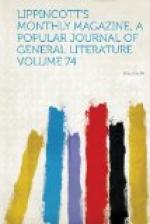Doubtless, many a stately minuet and frolicsome country-dance has been trod in those now dark and empty rooms by the Philadelphia belles and beaux of 1780, when, the rich furniture all set back against the walls, the general’s blacks were had up from the negro quarters with blaring horns and shrill fiddles to play for the quality. Alas! the horns and fiddles sound no more, the merry, grinning players are but a pinch of dust like their betters, their haughty master but a scorned memory where once he reigned so royally, while the modish guests who frisked it so gayly in satin and velvet have long, long ago shaken the powder out of their locks, tied up their jaws and packed themselves away in their scant winding-sheets, resigned to the mournful company of the worm.
Brief tenure held the fair chatelaine of this castle: a year and a half after the date inscribed upon her title-deeds the republic claimed the traitor’s possessions, and pretty Peggy was driven forth by the Executive Council to find a home with strangers, but fourteen days being granted her in which to prepare for her doleful journey. Our excellent forefathers were made of stern stuff to suit the humor of those trying times, and doubtless they did but their duty in ridding their country of the “traitor’s brood;” but for my part I can scarcely think, even at this late day, without a pang of indignant pity, of this innocent and forlorn young creature hounded forth from her father’s peaceful home in Philadelphia, with her child in her arms—driven almost to the protection of the man whose crime she abhorred, and from whom in her first frenzied grief she was even willing to be for ever separated. There have not been wanting certain persons, headed by that noble patriot and veracious gentleman, Colonel Aaron Burr, who from time to time have busied themselves in putting stray hints together with the intent to make Arnold’s wife an accomplice, if not the direct instigator, of his infamous design; but there is not in existence, so far as I have been able to learn, a particle of evidence sufficient to justify the casting of ever so small a stone at the memory of this most unfortunate lady, whose name is so pitilessly linked with that of the traitor.
She must have been extremely beautiful. I have had the good fortune to see her portrait, painted about 1795 at Bath, England, by Sir Thomas Lawrence, and now in the possession of her grand-niece, a lady to whom I am indebted for much that I have been able to gather of the character of Mrs. Arnold. The picture is taken in crayons, and the colors are wonderfully fresh and lovely after eighty years and a voyage across the sea, the delicate flesh-tints being especially well preserved. Besides real beauty of feature, there is an enchanting softness in the character of the face that seems to belong only to temperaments the most feminine and refined. A pale pink gown falls back from her gracious neck and shoulders, liberally and innocently displayed according to the fashion of the time, and is tied about her waist with a broad sky-blue ribbon: her hair, lightly dashed with powder and rolled away from her face, strays in rich curls about her throat. A child of two or three years leans upon her knee, and pulls at one of her ringlets with a roguish smile upon his chubby face.




